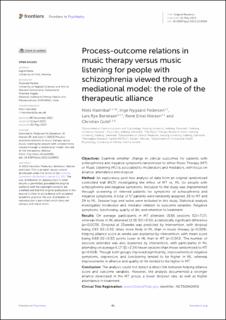| dc.contributor.author | Hannibal, Niels | |
| dc.contributor.author | Pedersen, Inge Nygaard | |
| dc.contributor.author | Bertelsen, Lars Rye | |
| dc.contributor.author | Nielsen, René Ernst | |
| dc.contributor.author | Gold, Christian | |
| dc.date.accessioned | 2023-10-03T12:18:18Z | |
| dc.date.available | 2023-10-03T12:18:18Z | |
| dc.date.created | 2023-06-05T17:23:51Z | |
| dc.date.issued | 2023 | |
| dc.identifier.citation | Frontiers in Psychiatry. 2023, 14 . | en_US |
| dc.identifier.issn | 1664-0640 | |
| dc.identifier.uri | https://hdl.handle.net/11250/3093790 | |
| dc.description.abstract | Objectives: Examine whether change in clinical outcomes for patients with schizophrenia and negative symptoms randomized to either Music Therapy (MT) or Music Listening (ML) is associated to moderators and mediators, with focus on alliance, attendance and dropout. Method: An exploratory post-hoc analysis of data from an original randomized controlled trial (RCT) investigating the effect of MT vs. ML for people with schizophrenia and negative symptoms. Inclusion to the study was implemented through screening of referred patients for symptoms of schizophrenia and negative symptoms. A total of 57 patients were randomly assigned, 28 to MT and 29 to ML. Session logs and notes were included in this study. Statistical analysis investigated moderator and mediator relation to outcome variables: Negative symptoms, functioning, quality of life, and retention to treatment. Results: On average, participants in MT attended 18.86 sessions (SD = 7.17), whereas those in ML attended 12.26 (SD = 9.52), a statistically significant difference (p = 0.0078). Dropout at 25 weeks was predicted by intervention, with dropout being 2.65 (SE = 1.01) times more likely in ML than in music therapy (p = 0.009). Helping alliance score at weeks was explained by intervention, with mean score being 0.68 (SE = 0.32) points lower in ML than in MT (p = 0.042). The number of sessions attended was also explained by intervention, with participants in ML attending on average 6.17 (SE = 2.24) fewer sessions than those randomized to MT (p = 0.008). Though both groups improved significantly, improvements in negative symptoms, depression, and functioning tended to be higher in ML, whereas improvements in alliance and quality of life tended to be higher in MT. Conclusion: The analysis could not detect a direct link between helping alliance score and outcome variables. However, the analysis documented a stronger alliance developed in the MT group, a lower dropout rate, as well as higher attendance in treatment. | en_US |
| dc.language.iso | eng | en_US |
| dc.rights | Navngivelse 4.0 Internasjonal | * |
| dc.rights.uri | http://creativecommons.org/licenses/by/4.0/deed.no | * |
| dc.title | Process-outcome relations in music therapy versus music listening for people with schizophrenia viewed through a mediational model: the role of the therapeutic alliance | en_US |
| dc.title.alternative | Process-outcome relations in music therapy versus music listening for people with schizophrenia viewed through a mediational model: the role of the therapeutic alliance | en_US |
| dc.type | Peer reviewed | en_US |
| dc.type | Journal article | en_US |
| dc.rights.holder | © 2023 Hannibal, Pedersen, Bertelsen, Nielsen and Gold | en_US |
| dc.description.version | publishedVersion | en_US |
| cristin.ispublished | true | |
| cristin.fulltext | original | |
| cristin.qualitycode | 1 | |
| dc.identifier.doi | 10.3389/fpsyt.2023.1120003 | |
| dc.identifier.cristin | 2152043 | |
| dc.source.journal | Frontiers in Psychiatry | en_US |
| dc.source.volume | 14 | en_US |
| dc.source.pagenumber | 11 | en_US |

